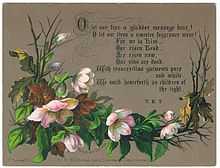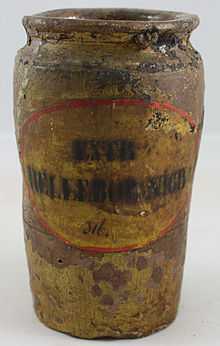Helleborus niger
| Christmas rose | |
|---|---|
| | |
| Flowers in winter | |
| Scientific classification | |
| Kingdom: | Plantae |
| (unranked): | Angiosperms |
| (unranked): | Eudicots |
| Order: | Ranunculales |
| Family: | Ranunculaceae |
| Genus: | Helleborus |
| Species: | H. niger |
| Binomial name | |
| Helleborus niger L. | |
Helleborus niger, commonly called Christmas rose or black hellebore, is an evergreen perennial flowering plant in the buttercup family, Ranunculaceae. It is poisonous.
Although the flowers resemble wild roses (and despite its common name), Christmas rose does not belong to the rose family (Rosaceae).
Description

Helleborus niger is an evergreen plant with dark leathery pedate leaves carried on stems 9–12 in (23–30 cm) tall. The large flat flowers, borne on short stems from midwinter to early spring, are white or occasionally pink.[1]

There are two subspecies: H. niger niger as well as H. niger macranthus, which has larger flowers (up to 3.75 in/9 cm across). In the wild, H. niger niger is generally found in mountainous areas in Switzerland, southern Germany, Austria, Slovenia, Croatia and northern Italy. Helleborus niger macranthus is found only in northern Italy and possibly adjoining parts of Slovenia.[1]
Horticulture
The plant is a traditional cottage garden favourite because it flowers in the depths of winter. Large-flowered cultivars are available, as are pink-flowered and double-flowered selections. It has been awarded an Award of Garden Merit (AGM) H4 (hardy throughout the British Isles) by the Royal Horticultural Society, as has one of its hybrids (see below).[2]
It can be difficult to grow well; acid soil is unsuitable, as are poor, dry conditions and full sun. Moist, humus-rich, alkaline soil in dappled shade is preferable. Leaf-mould can be dug in to improve heavy clay or light sandy soils; lime can be added to 'sweeten' acid soils.[1]
Cultivars
Since the 1950s, 'Potter's Wheel' has been one of the most famous names associated with H. niger. It originated with a self-sown seedling given by Major G.H. Tristram of Dallington, Sussex, to Hilda Davenport-Jones who had a nursery at nearby Washfield, Kent. The seedling proved to be exceptionally large-flowered, but it was too slow-growing to be 'bulked up' quickly, so she propagated it as a rigorously-selected uniform seed strain rather than as a vegetatively propagated cultivar.[1]
- 'Potter's Wheel'
- 'Marion' (double-flowered; there are also other unnamed double selections)
- 'Praecox' (early flowering)[2]
Hybrids
Nurserymen have tried for many years to cross H. niger with oriental hellebores (Lenten roses) H. × hybridus to increase the colour range available. Possible hybrids have been announced in the past, only to be disproved, but two crosses have been confirmed in recent years. 'Snow Queen', a white-flowered plant, arose spontaneously in Japan in the late 1990s, but does not look dramatically different from a good H. niger. Raised in 2000 by plant breeder David Tristram (whose father gave the first 'Potter's Wheel' to Washfield Nursery), Helleborus 'Walberton's Rosemary' is pink-flowered, extremely floriferous, and seems to be intermediate between its parents in many other characteristics.[3]
Helleborus niger has proved easier to cross with other hellebore species. Crosses between it and H. argutifolius (formerly known as H. corsicus) are called H. × nigercors. First made in 1931, the hybrid is a large, tough plant with white flowers flushed with green; they are said to be the best of all hellebores for cut flowers.[1] It has been awarded an AGM H4.[2] Double-flowered plants are available.[2]
Hybrids between H. niger and H. × sternii (itself a hybrid, between H. argutifolius and H. lividus) were originally called H. × nigristern, but this name has been changed in favour of H. × ericsmithii (commemorating the plantsman who made the cross in the 1960s and introduced it in 1972, through The Plantsmen nursery). At their best, the hybrids combine the hardiness of H. niger and H. argutifolius, the large flowers of H. niger, and the leaf and flower colour of H. lividus.[1] Cultivars such as 'Bob's Best', 'HGC Silvermoon', 'Ruby Glow' and 'Winter Moonbeam' are available.[2]
Helleborus niger has also been crossed with H. lividus; the hybrid was known informally as H. × nigriliv, but its correct name is H. × ballardiae, commemorating Helen Ballard, the famous plantswoman who first made the cross in the early 1970s.[1]
Poisonous constituents
Helleborus niger contains protoanemonin,[4] or ranunculin,[5] which has an acrid taste and can cause burning of the eyes, mouth and throat, oral ulceration, gastroenteritis and hematemesis.[6]
Folklore and early medicinal uses

Helleborus niger is commonly called the Christmas rose, due to an old legend that it sprouted in the snow from the tears of a young girl who had no gift to give the Christ child in Bethlehem.
One subspecies blooms at the abbey in England believed by some to have been established by St. Thomas. There is a source that claims it blooms near the new calendar date of January 6. This date had been Christmas Day under the old Julian calendar. So when Christmas Day under the new calendar came around and the flower did not bloom, it was such a frightful omen that England did not adopt the Gregorian calendar at that time in 1588; adoption had to wait until 1751.
In the Middle Ages, people strewed the flowers on the floors of their homes to drive out evil influences. They blessed their animals with it and used it to ward off the power of witches. These same people believed, however, that witches employed the herb in their spells and that sorcerers tossed the powdered herb into the air around them to make themselves invisible.
In the early days of medicine, two kinds of hellebore were recognized: black hellebore, which included various species of Helleborus, and white hellebore (now known as Veratrum album or "false hellebore", which belongs to a different plant family, the Melanthiaceae).[7] "Black hellebore" was used by the ancients to treat paralysis, gout and particularly insanity, among other diseases. "Black hellebore" is also toxic, causing tinnitus, vertigo, stupor, thirst, a feeling of suffocation, swelling of the tongue and throat, emesis and catharsis, bradycardia (slowing of the pulse), and finally collapse and death from cardiac arrest.[8] Research in the 1970s, however, showed that the roots of H. niger do not contain the cardiotoxic compounds helleborin, hellebrin, and helleborein that are responsible for the lethal reputation of "black hellebore". It seems that earlier studies may have used a commercial preparation containing a mixture of material from other species such as Helleborus viridis, green hellebore.[9]
In antiquity the most famous place for the black hellebore was the Phokian city of Antikyra[10] in Greece.
References
- ↑ 1.0 1.1 1.2 1.3 1.4 1.5 1.6 Rice, Graham & Strangman, Elizabeth, The Gardener's Guide to Growing Hellebores, David & Charles/Timber Press (1993) ISBN 0-7153-9973-X
- ↑ 2.0 2.1 2.2 2.3 2.4 RHS Plant Finder 2009–2010, p349, Dorling Kindersley, London, 2009, ISBN 978-1-4053-4176-9
- ↑ The Holy Grail of hellebores Garden writer and journalist Graham Rice's blog
- ↑ Olson, Kent R., Poisoning & Drug Overdose, p312 at Google Book Search, accessed 12 January 2009
- ↑ Smolinske, Susan C., Toxicity of Houseplants, pp38, 153 at Google Book Search, accessed 12 January 2009
- ↑ Olson, Kent R, Poisoning & Drug Overdose, p309 at Google Book Search, accessed 12 January 2009
- ↑ Mobot.org
- ↑ "1911 Encyclopædia Britannica, citing Codronchius (Comm.... de elleb., 1610), Castellus (De helleb. epist., 1622), Horace (Sat. ii. 3.80-83, Ep. ad Pis. 300).".
- ↑ Smolinske, Susan C., Toxicity of Houseplants, pp153-4 at Google Book Search, accessed 12 January 2009
- ↑ Theophrastus, HP ΙΧ 10.2-4; Dioscorides, De materia medica IV 148-152, 162; Plinius, HN XXV 48-52